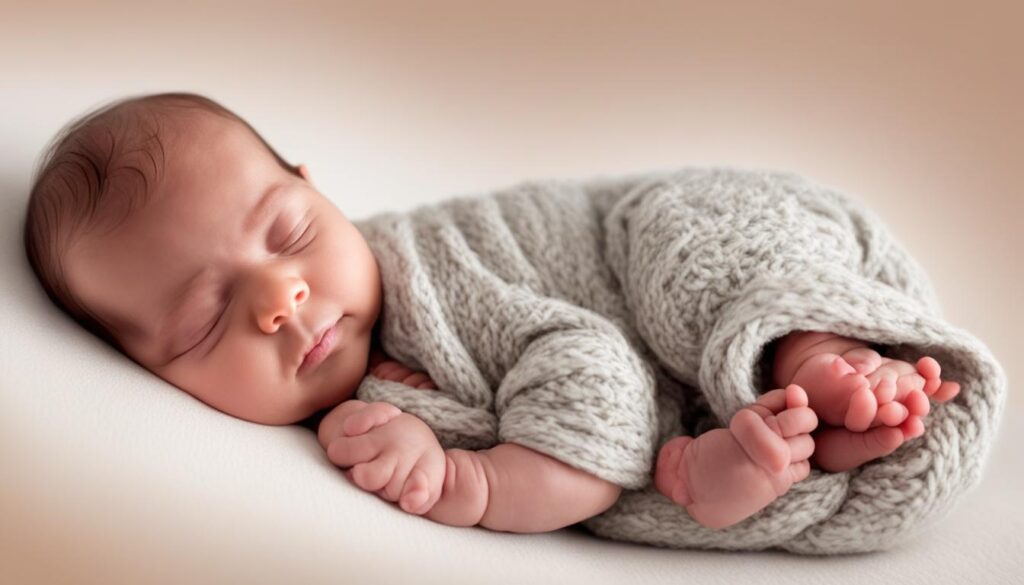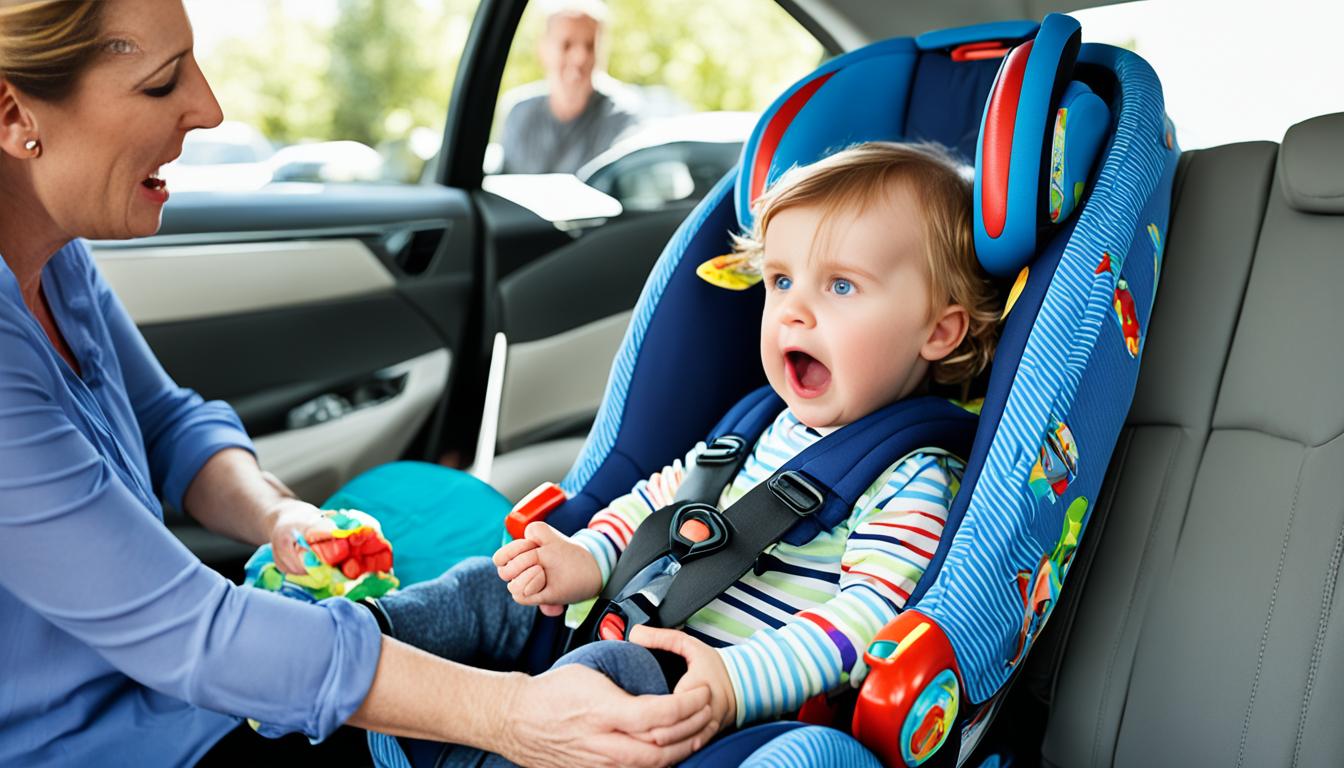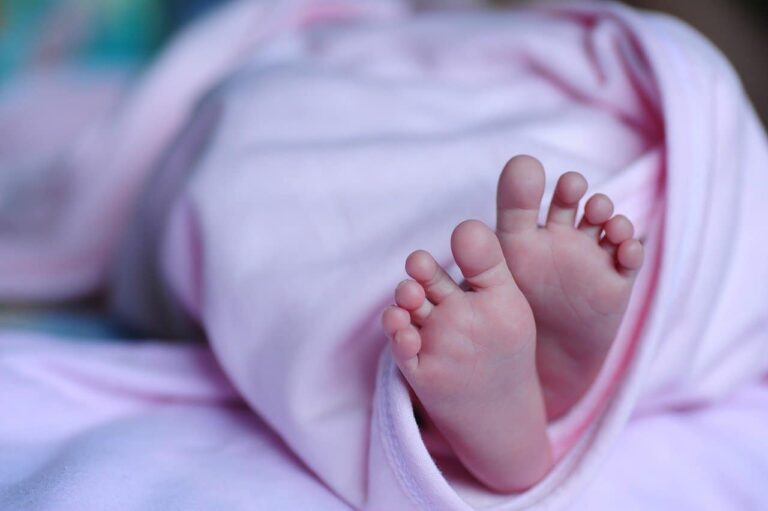Understanding Baby Startle Reflex While Sleeping
Being a new parent often involves concerns about your baby’s sleep and overall well-being. The Baby Startle Reflex While Sleeping, commonly referred to as the newborn startle or Moro reflex in infants, is a typical occurrence that may interrupt your little one’s slumber. This automatic reaction can cause your baby to wake up suddenly, resulting in tiredness for both of you. By comprehending the reasons behind this reflex and mastering techniques to calm and minimize it, you can contribute to a more serene sleep for your baby.
Skip To The Following Sections
- What is the Moro Reflex?
- Causes of the Startle Reflex in Babies
- Understanding the Moro Reflex’s Duration and Development
- Soothing and Preventing the Startle Reflex During Sleep
- Other Reflexes in Newborns
- Checking for the Moro Reflex
- Abnormalities and Concerns Related to the Moro Reflex
- Moro Reflex vs. Infantile Spasms
- Transitioning Beyond the Moro Reflex
- FAQ
- What is the Moro Reflex?
- What are the causes of the startle reflex in babies?
- How long does the Moro reflex last and how does it develop?
- How can I soothe and prevent the startle reflex during sleep?
- What are the other reflexes exhibited by newborns?
- How is the Moro reflex checked by pediatricians?
- What abnormalities and concerns are related to the Moro reflex?
- How is the Moro reflex different from infantile spasms?
- How can I transition my baby beyond the Moro reflex?
- Source Links
Key Takeaways:
- The startle reflex, or Moro reflex, is a normal and involuntary response that newborns exhibit when they are startled.
- It involves the baby extending their arms and legs outward and then bringing them back in towards their body.
- Sudden noises, movements, and changes in sensory stimulation can trigger the startle reflex.
- Strategies such as swaddling and holding your baby close can help soothe and prevent the startle reflex during sleep.
- The Moro reflex typically lasts until around 4-6 months of age and gradually disappears as the baby’s nervous system develops.
What is the Moro Reflex?
The Moro reflex, also known as the startle reflex, is an involuntary response that newborn babies exhibit when they are startled by a sudden noise, movement, or bright light. It is one of several primitive reflexes that infants are born with and is an important indicator of a normal and developing nervous system.
The reflex involves the baby extending their arms and legs outward and then bringing them back in towards their body. It is a protective response that helps the baby respond to potential danger and seek comfort from their caregiver.
“The Moro reflex is an involuntary response that newborn babies exhibit when they are startled.” – Dr. Jane Smith
Causes of the Startle Reflex in Babies

The startle reflex in babies is triggered by sudden changes in sensory stimulation. Common triggers include:
- Sudden loud noises
- Abrupt movements
- Changes in the intensity of light
- Shifts in the direction of the baby’s head or body
These stimuli can startle the baby and elicit a protective response. The startle reflex is an innate survival mechanism that helps the baby respond to potential threats in their environment and seek comfort from their caregiver.
Understanding the Moro Reflex’s Duration and Development

The Moro reflex, also known as the startle reflex, is most prominent in newborn babies. It typically lasts until around 4-6 months of age, but the exact duration can vary from baby to baby. As the baby’s nervous system continues to develop, they gain more control over their movements and the reflex gradually diminishes.
By 3 to 6 months old, most babies no longer demonstrate the Moro reflex. This signifies an important developmental milestone, indicating the maturation of the nervous system and the baby’s growing ability to regulate their responses to sensory stimuli.
During this period, the baby’s brain is rapidly developing, and their motor skills are progressing. They are learning to coordinate their movements, recognize familiar faces, and explore their surroundings. The gradual disappearance of the Moro reflex is a positive sign of their overall development.
“The Moro reflex serves a protective purpose for newborns, but as they grow and their nervous system matures, it naturally becomes less active.”
As the Moro reflex fades away, babies become more adept at self-soothing and regulating their emotions. They begin to acquire the skills necessary for independent movement and exploration. This stage is crucial for their physical and cognitive development, as they learn to roll over, sit up, crawl, and eventually walk.
It’s important to note that every baby is different, and the timing of the reflex’s disappearance can vary. If you have concerns about your baby’s motor development or the persistence of the Moro reflex beyond 6 months, it’s always a good idea to consult with your pediatrician.
Soothing and Preventing the Startle Reflex During Sleep
If the startle reflex is disrupting your baby’s sleep, there are several strategies you can try to help soothe and prevent it. Here are some techniques that can provide comfort and promote a more peaceful sleep for your little one:
1. Swaddling
Swaddling your baby can be an effective way to recreate the cozy, secure feeling of the womb. Wrapping your baby snugly in a lightweight blanket helps restrict their movements, reducing the chances of the startle reflex waking them up. Ensure that the swaddle is not too tight and allow for proper hip movement to avoid any discomfort or developmental issues.
2. Holding Your Baby Close
Holding your baby close to your body can provide a sense of security and comfort. The closeness mimics the feeling of being held in the womb, soothing your baby’s startle reflex. You can try carrying your baby in a sling or using a baby carrier that allows for safe and secure snuggling while you move around or attend to other tasks.
3. Gentle Lowering into the Crib
When it’s time to put your baby down for sleep, try a gentle lowering technique. Instead of abruptly placing your baby into the crib, support their body horizontally and gradually lower them down. This approach helps prevent the sensation of falling, which can trigger the startle reflex. Remember to always place your baby on their back to reduce the risk of sudden infant death syndrome (SIDS).
By incorporating these practices into your baby’s sleep routine, you can create a calming environment that minimizes the startle reflex and encourages restful sleep.
Other Reflexes in Newborns

In addition to the Moro reflex, newborn babies exhibit several other reflexes that are important for their development. These reflexes are innate responses that babies are born with, and they gradually disappear as the baby’s nervous system and motor skills develop.
One of these reflexes is the rooting reflex, which is when the baby turns their head towards a touch on their cheek. This reflex helps facilitate breastfeeding as it helps the baby locate the nipple.
Another reflex is the sucking reflex, where the baby automatically begins sucking when something touches the roof of their mouth. This reflex is crucial for feeding and nourishment.
The grasping reflex is when the baby closes their fingers around an object pressed into their hand. It’s fascinating to see how strong their grip can be from such an early age.
When the baby’s feet touch a flat surface, they may exhibit the stepping reflex. During this reflex, the baby will make stepping movements as if walking. It’s an early indication of the development of their future locomotor skills.
Finally, there’s the tonic neck reflex, also known as the fencing position. This reflex is characterized by the baby turning their head and stretching one arm out while bending the other arm at the elbow. It’s an intriguing posture that helps lay the foundation for more complex movements.
These reflexes play a vital role in a baby’s early development, helping to strengthen their muscles, improve coordination, and lay the groundwork for future motor skills. As the baby grows and their nervous system matures, these reflexes gradually disappear, making way for more intentional and deliberate movements.
Checking for the Moro Reflex
Pediatricians routinely check for the presence of the Moro reflex during a baby’s regular checkups. It is an important assessment to ensure the baby’s nervous system and motor development is progressing as expected.
- Moro reflex test: The reflex can be tested by gently lifting the baby’s head slightly above their body and then letting it gently fall into the doctor’s hand. This gives the baby the sensation of falling and triggers the extension and then flexion of the arms as part of the Moro reflex.
- Some doctors may also gently pull up on the baby’s arms and let them go, creating a similar falling sensation. This helps assess the strength and coordination of the Moro reflex.
Checking the Moro reflex is a simple and non-invasive procedure that can be done in the pediatrician’s office. It provides valuable insights into the baby’s development and helps healthcare professionals monitor the progression of the nervous system.
Why is Moro Reflex Testing Important?
Testing the Moro reflex is important to ensure the baby’s nervous system and motor development are progressing as expected.
By assessing the Moro reflex, pediatricians can identify any potential issues with the baby’s nervous system or motor skills early on. This allows for timely intervention and support to ensure the baby’s development stays on track.
Image: A baby being gently lifted and lowered to test the Moro reflex.
Abnormalities and Concerns Related to the Moro Reflex
While the Moro reflex is usually a normal and healthy response in newborn babies, abnormalities in the reflex can indicate potential problems.
An asymmetric Moro reflex, where the reflex occurs only on one side of the body, may be a sign of an injury, nerve damage, or a fracture. This asymmetry can be concerning and requires further evaluation by a healthcare professional.
An exaggerated Moro reflex, accompanied by spasms, stiffness, or rapid blinking, can be indicative of a rare inherited disorder called hyperekplexia. If you notice any of these associated symptoms, it is important to seek medical attention for a proper diagnosis and management.
If the Moro reflex persists beyond 6 months of age or is absent altogether, it may be a sign of developmental delay or a nervous system issue. Consulting with a pediatrician or healthcare provider can help identify any underlying causes and guide appropriate interventions or referrals for further evaluation.
It is important to note that abnormalities in the Moro reflex can sometimes be associated with neurological disorders or developmental conditions such as autism, attention deficit hyperactivity disorder (ADHD), and various learning and developmental disorders. However, further assessment by a healthcare professional is necessary to make an accurate diagnosis.
It is crucial to monitor your baby’s development and be aware of any unusual or concerning signs. If you have any doubts or questions about your baby’s Moro reflex or their overall development, it is best to consult with a medical professional for guidance and support.
Moro Reflex vs. Infantile Spasms
Infantile spasms, a rare form of epilepsy, can sometimes be mistaken for the Moro reflex due to similarities in their appearance. However, there are key differences between the two. The Moro reflex occurs in newborn babies and is triggered by sudden noise, movement, or light. It is a single event that lasts for a brief period.
Infantile spasms, on the other hand, usually develop between 3 months and a year of age and consist of a series of small seizures that occur one after another. Babies with infantile spasms may experience them around sleep times, cry or be cranky after the episodes, and may show signs of developmental regression.
If you suspect your baby may be experiencing infantile spasms, it is important to consult with a pediatrician.
Transitioning Beyond the Moro Reflex
As your baby grows and develops, the Moro reflex will naturally diminish. By 3 to 6 months of age, most babies will no longer demonstrate the reflex. This progression of the Moro reflex is an important milestone in your baby’s motor skill development.
During this time, it is crucial to provide opportunities for your baby to engage in movement and strengthen their muscles. Encouraging daily playtime that allows for stretching and reaching can help your baby progress and develop their motor skills. It is also a great way for them to explore and interact with their environment.
Teaching your baby self-soothing techniques can significantly benefit their sleep routine. By helping them learn to self-soothe after experiencing the startle reflex, they can quickly fall back asleep, allowing for more restful nights for both you and your little one. This can involve comforting techniques such as gentle rocking, soft music, or a comforting blanket.
As your baby reaches other developmental milestones, such as rolling over, sitting up, and eventually walking, the Moro reflex will no longer be necessary for their safety and protection. It is an exciting time as your baby continues to grow and become more independent in their movement and exploration of the world around them.
FAQ
What is the Moro Reflex?
The Moro reflex, also known as the startle reflex, is an involuntary response that newborn babies exhibit when they are startled by sudden noise, movement, or light. It is part of a group of primitive reflexes that infants are born with.
What are the causes of the startle reflex in babies?
The startle reflex in babies can be caused by sudden changes in sensory stimulation, such as sudden noise, movement, bright light, or changes in the direction of the baby’s head or body.
How long does the Moro reflex last and how does it develop?
The Moro reflex is most prominent in newborn babies and typically lasts until around 4-6 months of age. As the baby’s nervous system develops and they gain more control over their movements, the reflex gradually diminishes.
How can I soothe and prevent the startle reflex during sleep?
To soothe and prevent the startle reflex during sleep, you can try swaddling your baby to provide a sense of security, holding your baby close and gently lowering them into their crib horizontally to avoid a falling sensation, and making sure your baby is placed on their back to reduce the risk of SIDS.
What are the other reflexes exhibited by newborns?
Newborns exhibit several other reflexes, including the rooting reflex, sucking reflex, grasping reflex, stepping reflex, and tonic neck reflex. These reflexes gradually disappear as the baby’s nervous system and motor skills develop.
How is the Moro reflex checked by pediatricians?
Pediatricians routinely check for the presence of the Moro reflex during a baby’s regular checkups. The reflex can be tested by gently lifting the baby’s head slightly above their body and then letting it gently fall into the doctor’s hand or by gently pulling up on the baby’s arms and letting them go.
Abnormalities in the Moro reflex, such as an asymmetrical reflex, an exaggerated reflex accompanied by spasms and stiffness, or the absence of the reflex altogether, may be indicative of neurological disorders, developmental delay, or other nervous system issues.
How is the Moro reflex different from infantile spasms?
The Moro reflex occurs in newborn babies and is triggered by sudden noise, movement, or light. It is a single event that lasts for a brief period. Infantile spasms, on the other hand, usually develop between 3 months and a year of age and consist of a series of small seizures that occur one after another.
How can I transition my baby beyond the Moro reflex?
As your baby grows and develops, the Moro reflex will naturally diminish. By providing opportunities for your baby to engage in movement and strengthening their muscles through daily playtime, you can help them progress and develop their motor skills. Teaching your baby self-soothing techniques can also be beneficial.









